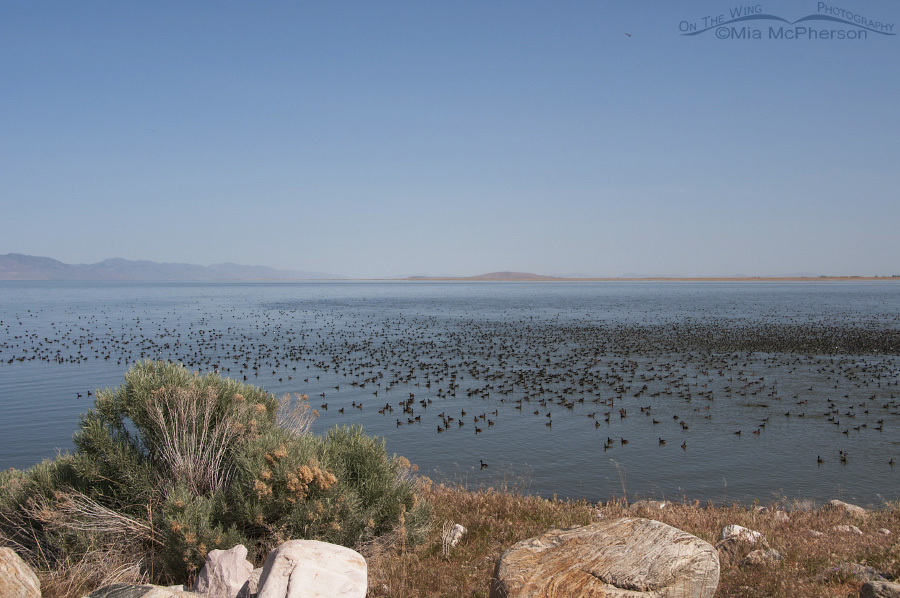
Great Salt Lake as seen from the Antelope Island Causeway on May 13, 2012
Utah’s water crisis and the drought we have been experiencing has been in the news a lot lately but much of it isn’t news to me as someone who is out in the field and views the Great Salt Lake quite often. The water level of the Great Salt Lake is nearing a 167 year record low and that is a very big issue.
We are getting a bit of rain now from spring time storms but that doesn’t help much at all because the lake actually gets it water from three rivers, the Bear, Weber and the Provo/Jordan River and the Great Salt Lake and the surrounding marshes depend on the flow from those rivers. Rain here is soaked up into the dry ground and not much of it reaches the lake unless it is falling right on it. The lake has no outlet and much of the water is lost by evaporation. The hotter it gets the more water the lake loses. Our climate is changing, it is getting hotter. There shouldn’t even be a debate about that.
When I arrived in Utah in 2009 the Great Salt Lake looked wonderful to me, I was missing the Gulf of Mexico but the lake and the birds there made me feel more at home.
The image above was taken on May 13, 2012 when the water came right up to the shoreline near the first bridge on the causeway. There were thousands and thousands of Eared Grebes feeding on the brine flies in the lake along with thousands of other birds. At the far left side of the frame is the Promontory Range.
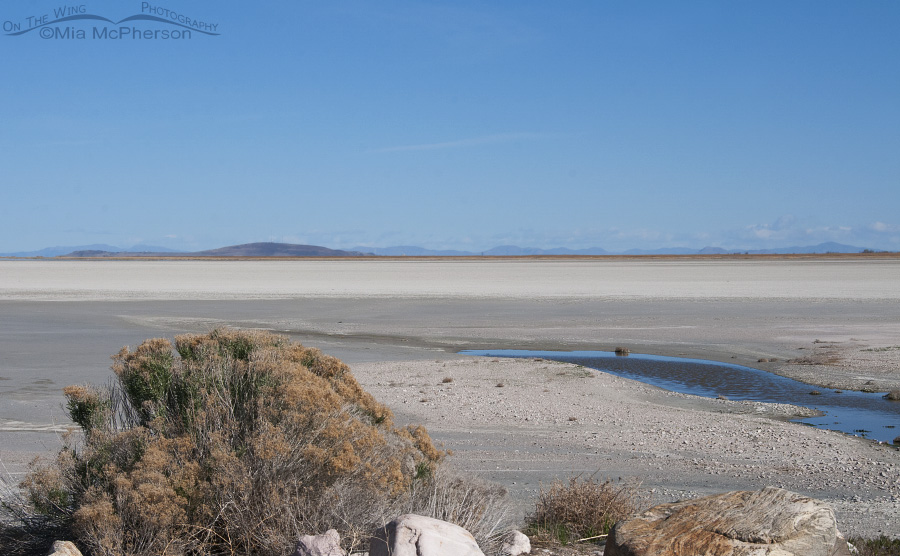
Great Salt Lake as seen from the Antelope Island Causeway on April 12, 2015
This image was taken in the same location just a few weeks shy of three years after the one above. You can see the same rocks and Rabbitbrush in the frame but I was zoomed in a bit more because I wanted to shorten the distance between the Antelope Island Causeway so the mudflats are easier to see. This image shows that the water is pretty much gone between the causeway and some land jutting out from near the Ogden Bay WMA, all I can see is dried mudflats.
I don’t know why there is still water under the little bridge because it has no visible source but I doubt that you could fit 100 Eared Grebes in that small area of water.
We had an unusually warm, record breaking winter with low snowfall even in the mountains and that snow feeds the streams that feed the rivers that feed the Great Salt Lake.
The Great Salt Lake is drying. Sail boats were pulled out of the Great Salt Lake Marina by crane this week because the lake is so dry they weren’t floating on water, they were mired in mud.
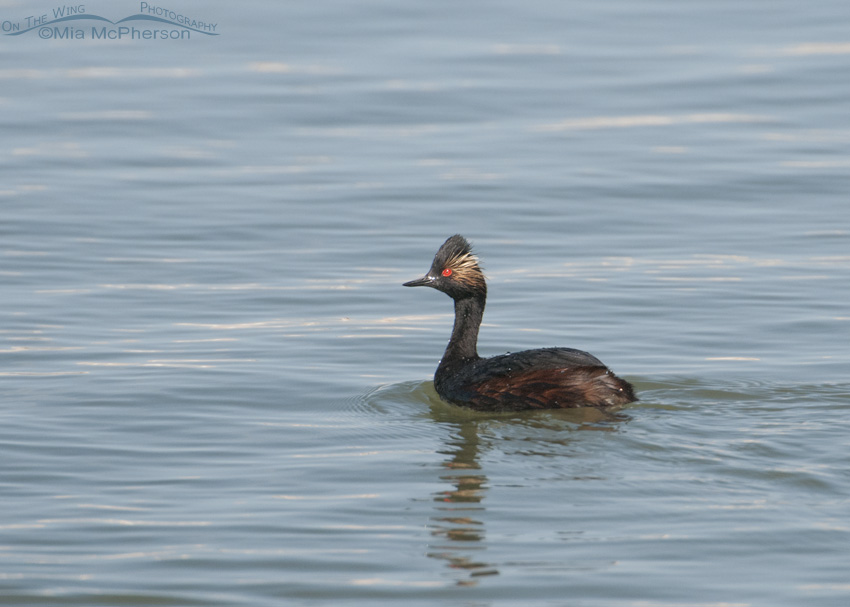
An Eared Grebe on the Great Salt Lake
Eared Grebes are unique in that for most of the year they are closely associated with hyper saline lakes like the Great Salt Lake in Utah or Mono Lake in California where they feed almost exclusively on brine flies and brine shrimp. California is also in drought and Mono Lake’s water level is also low. Without water in these lakes Eared Grebes have few places to go that are hyper saline.
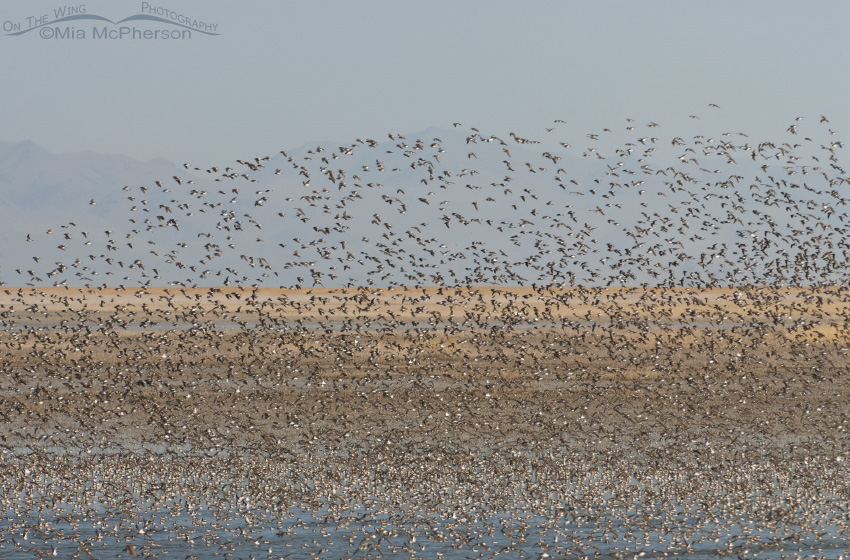
Wilson’s Phalarope flock over the Great Salt Lake
Wilson’s Phalaropes; a species of small shorebird, also depend on hyper saline lakes to survive and they are as unique as the Eared Grebes in their diet and the length of time they spend on the super saline lakes.
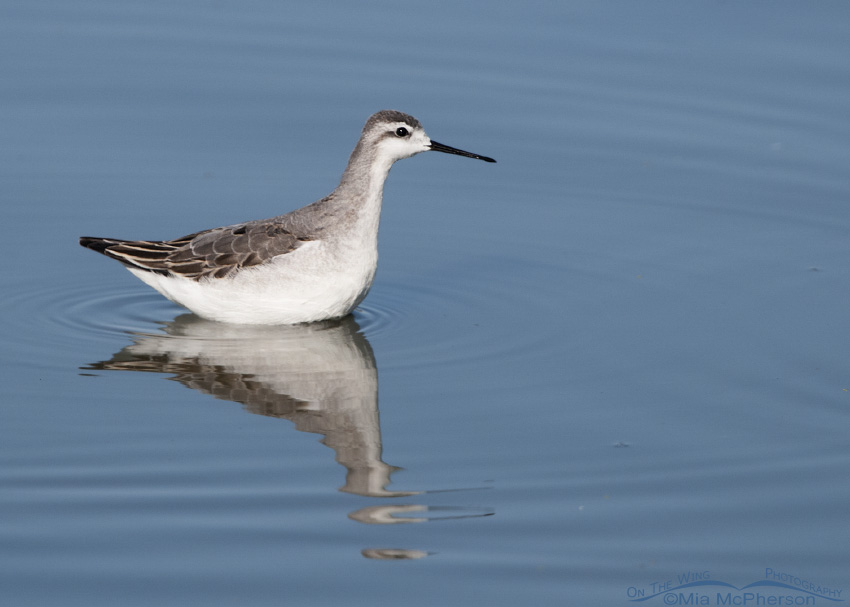
Wilson’s Phalarope in nonbreeding plumage
During the period of time that Wilson’s Phalaropes and Eared Grebes are in the Great Salt Lake area they number in the hundreds of thousands to feed on the billions of brine flies and brine shrimp that live in the lake.
I live in an area of the Great Basin hub of the Pacific Flyway, the flyway is used annually by millions of birds and it is an important rest stop for many bird species on their way to their breeding grounds or when they head south to their wintering grounds.
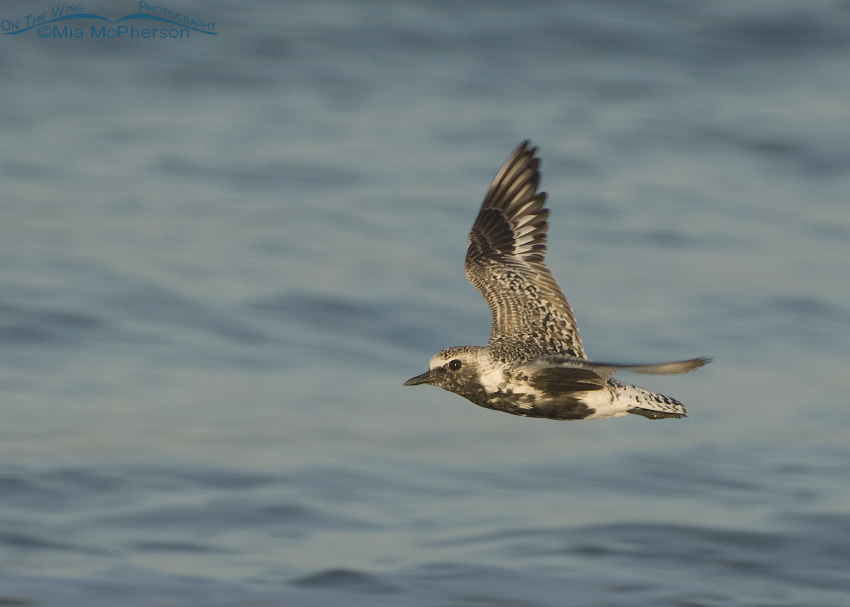
Black-bellied Plover in flight
Some of the birds I used to see on the Gulf Coast of Florida are bird species that migrate through this flyway and they rest and fuel up near or on the Great Salt Lake like this Black-bellied Plover I photographed at Fort De Soto County Park in Florida. I’ve been expecting them to arrive any day now along with many other species of shorebirds heading north to their breeding grounds. The Great Salt Lake is important to their survival.
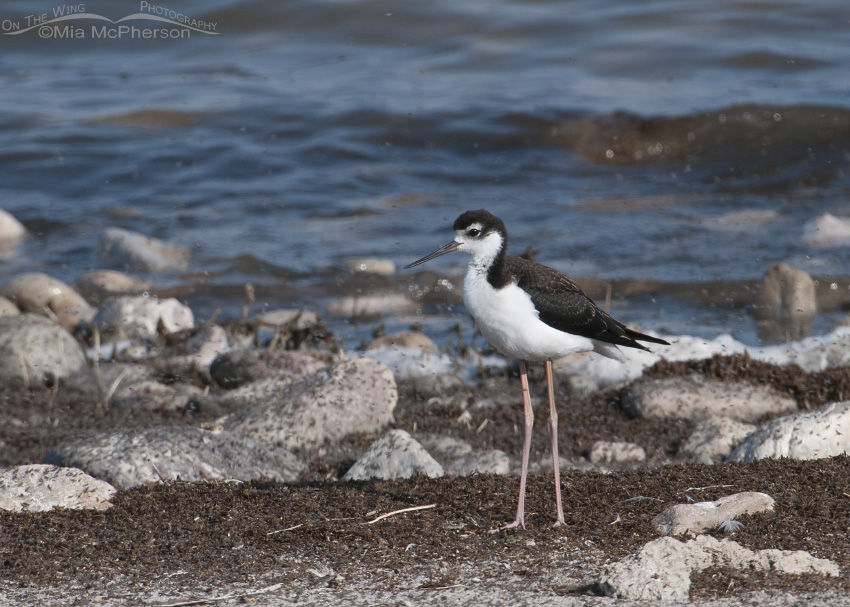
Black-necked Stilt on the shoreline of the Great Salt Lake surrounded by brine flies, a prey item for this species.
If the water doesn’t reach the Great Salt Lake I have to wonder how many of these birds will perish on their migration because they could not fuel up for their long journeys if the lake dries up. If they don’t get there they can’t breed and if they can’t breed their survival as a species is at risk.
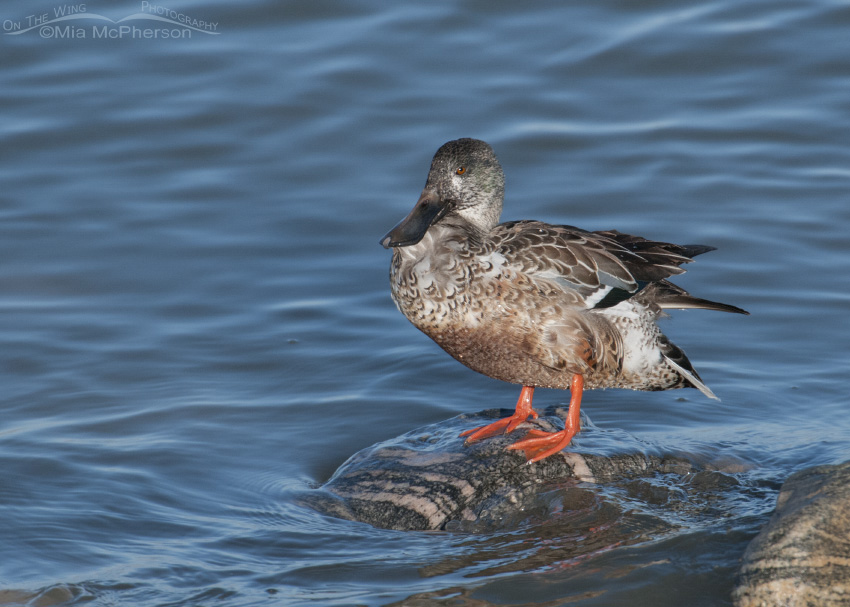
Northern Shoveler next to the Great Salt Lake
It isn’t just shorebirds that depend on the Great Salt Lake and its surrounding marshes, many waterfowl species migrate through the flyway or arrive here to breed in the surrounding marshes. During the fall hundreds of thousands of ducks can be seen on the lake. It is wonderful spectacle to see for the bird watchers, nature lovers and visitors that come to see Antelope Island State Park.
There is talk about building a pipeline north of the Great Salt Lake to pipe water to the Wasatch Front from the Bear River. The Bear River is a critical water source for Bear River Migratory Bird Refuge and for the Great Salt Lake and I have serious concerns about that water being taken away from the lake and the refuge.
I must admit there are days that the Great Salt Lake smells. Stinks. It is caused by algal blooms and bacteria. It isn’t always there but the smell does bother some folks.
This is a comment from a person who commented on an article on KSL about the Great Salt Lake level drastically dropping. I hope the person was joking because of the Great Salt Lake dries up there will be problems not just for birds and wildlife but for people too.
The more the lake dries the more dust there will be in the air and the Salt Lake Valley already has horrible days where the air quality just plains sucks. Where it can be hard for people to breathe. Harder still for the people who have allergies and asthma. Beyond those issues there is also a problem with mercury, heavy metals and other pollutants that will be exposed to air. We get hurricane force winds here that turn the sky milky white with dust and particulates, just what will be in the air we breathe? And what are the long term effects of that on humans, especially children?
 I think “Maxx” might need to do more research. Yes the lake level was extremely high in the 1980’s, yes there were floods.
I think “Maxx” might need to do more research. Yes the lake level was extremely high in the 1980’s, yes there were floods.
And yes the lake has had historical cycles where the water level waxes and wanes.
But we are currently using water at a higher rate, the reservoirs aren’t full, the population is growing and if the water doesn’t come from the rivers to feed the Great Salt Lake I don’t see how “it will come back soon”. Sure there will still be cycles.
Dry and dryer.
The Great Salt Lake water level can be viewed here as a graph for the last few years, I clicked 2012 too.
We depend on snow melt to fill our reservoirs and some of the snow that falls on the mountains is lake effect snow. Lake effect snow is often thick snow fall, so more lake effect means more snow. If the surface area of the lake decreases so does the amount of lake effect snow.
I’ve been up in the mountains recently and have seen how low the water levels are in the reservoirs. It isn’t a pretty picture. And I know pretty pictures.

Bear River Migratory Bird Refuge
Before the water from the Bear River reaches the Great Salt Lake it goes through the Bear River Migratory Bird Refuge which is also a very important resting and refueling area for migratory birds that use the Great Basin Hub of the Pacific Flyway. There are also thousands of birds that nest at the refuge including ducks, shorebirds, grebes and songbirds. So what happens when less water reaches the marshes on the refuge? Where else do all those birds have to go to breed, nest and raise their young if the habit changes?
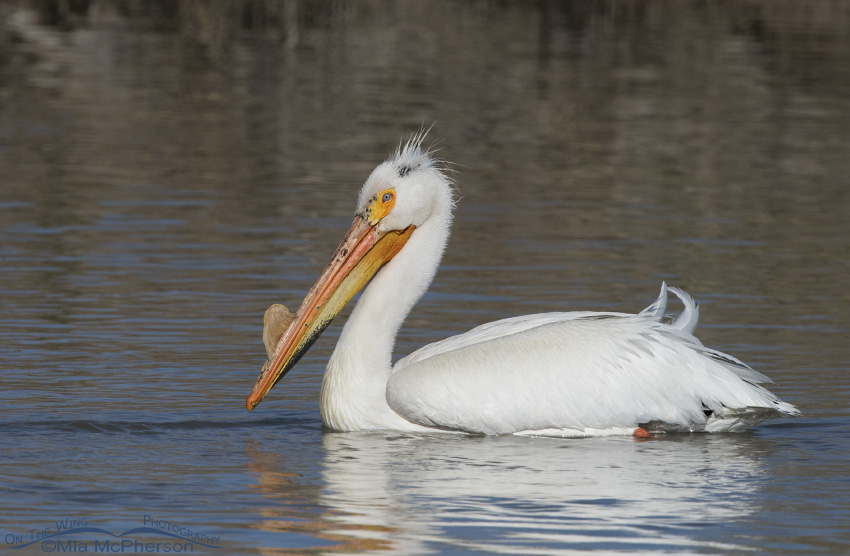
An American White Pelican at the Bear River Migratory Bird Refuge
What happens to the American White Pelicans that fly to the refuge to feed and to get food for their young that are miles way on islands in the Great Salt Lake? What happens to those pelican nesting sites when the water around them disappears and they are no longer protected from the predators that wouldn’t have come across higher water to the islands?
If I were a hunter, which I am not, I would be up at arms about the proposed pipeline because the refuge needs the water it gets from the Bear River, it is vital. Less water, less suitable habitat. Less habitat. Fewer birds.
I know some people might think “they are just birds” or “who cares if the lake dries up”. We should all care because if one part of or environment fails there is a ripple effect and we will all feel it in the Salt Lake Valley.
This water crisis isn’t just about the birds although they are very important to me personally as a bird photographer and it isn’t about just the Great Salt Lake. It is about our environment. It is about our quality of life.
But is also about planning for the future. It is about conserving and reducing our water consumption now.
On the 15th of this month there was about 7.5 inches of snow on the ground where I live and I hoped there would be snow on Antelope Island too so off to the island I went but on my way I saw some thing that made me angry. There was seven and a half inches of snow on the ground and is the darkness I see that the Taylorsville LDS Church sprinklers were spraying water over the 7.5 inches of snow. They do have a lush expanse of grass in the image below, don’t they?
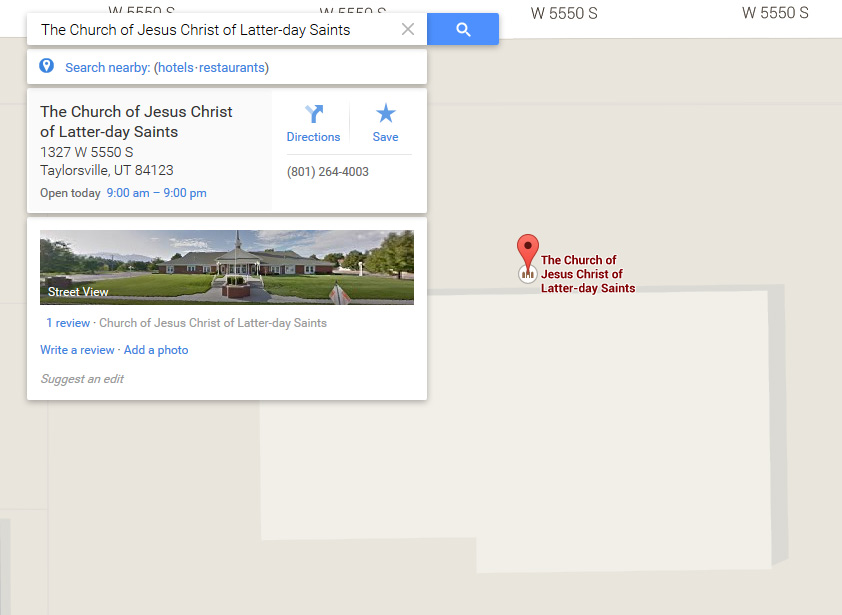
Sadly they aren’t the only ones who water when there isn’t a need to. Businesses water every day. I have driven along rural roads when it is pouring rain and seen irrigation running in agricultural fields. I’ve seen people watering their driveways and precious water running in the streets from sprinklers that aren’t adjusted properly.
When I left Florida, a state with ample rainfall, they were in a drought and severe restrictions were in place about watering lawns, washing cars and just plain wasting water. It kind of blew my mind to come to Utah; a desert state with far less annual rainfall, and see lush, green bluegrass lawns every where and to see lawns watered every day.
In Florida people were tearing out their lawns and replacing them with drought tolerant plants and shrubs. In California the same thing is happening because of the extreme drought they are in.
We can go green by using less green.
Utah and Utahns need to think about ways to reduce our water consumption today. Not in 2020, now. For the birds, for the wildlife, for the land and for future generations.
One thing I know for certain is that we can’t drink dust.
Mia



Looks a lot like CA Mia. 🙁 Yes, the lawns have to go! As soon as I can afford it mine are going! I may not water them this summer and just let them die! I am only buying drougnt tolerant and native plants to put in my yard. Irrigation is where all the water is going. Now if we could just get the farmers to stop putting in thousands and thousands of acres of new Almond orchards. They are water intensive trees and the farmers are drilling very deep wells and will be draining the deep aquifers while homeowners wells go dry. 🙁 Really is a crime! No restrictions on pumping water out of the aquifers. Big almond market in China is driving this. Not good!! Beautiful photos as always!
I have seen whole lakes east of here disappear over the years . luckily the birds are still coming, just changing their routes a bit.but there are years when they won’t lay eggs and the population drops.Our denial is over the glaciers in themountains receding the scientists predict our glaciers in the rockies will dry up-our source of water.
Many good points made in this post. I dare say there is no danger of the Great Salt Lake ever flooding again due to the increased upstream use of the water (as you wrote in your response to Maxx). We are one of the driest states yet have one of the highest rates of water use! Sadly there are many climate change deniers in the country and they vote for the fools in Washington.
You mean CLIMATE CHANGE IS REAL????!!!!! Try telling that to the morons in Washington, DC!!!!!
The moron’s in DC who deny climate change need a wake up call. Or steel-toed boots up their butts.